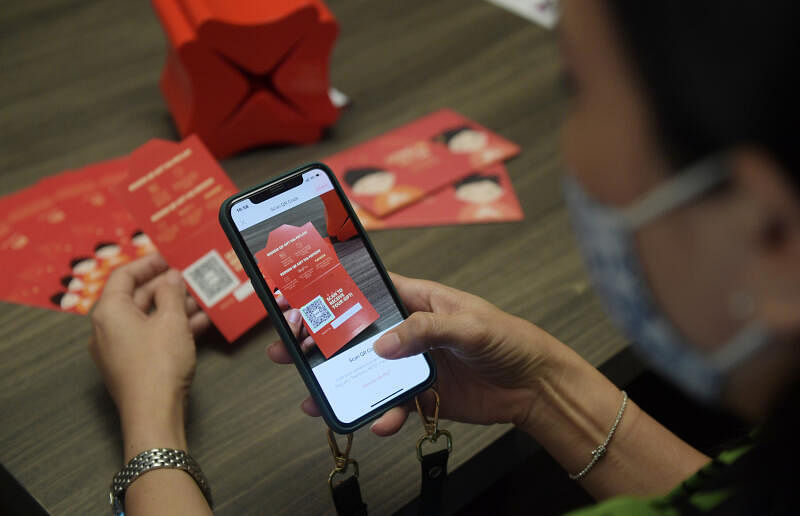Go digital: How to send or receive an e-hongbao this Chinese New Year
Sign up now: Get ST's newsletters delivered to your inbox

All the major banks here will offer e-hongbao by early next month.
ST PHOTO: ALPHONSUS CHERN
Lester Wong
Follow topic:
SINGAPORE - Banks in Singapore are rolling out digital red packets, or hongbao, in full force this Chinese New Year (CNY) in response to social distancing requirements amid the Covid-19 pandemic.
Just like physical red packets, these e-hongbao come in different designs, albeit digital ones, with customisable greetings or graphics, depending on the bank.
All funds are sent via the instant transfer service PayNow, which maps people's bank accounts to either their NRIC or mobile number.
All the major banks here - DBS Bank, OCBC Bank, UOB, Citibank, Standard Chartered Bank and Maybank - will offer e-hongbao by early next month. The first day of CNY falls on Feb 12 this year.
The e-hongbao drive is part of a larger shift towards e-gifting encouraged by the Monetary Authority of Singapore (MAS), which last week asked Singaporeans to go digital to reduce physical queues for new bank notes.
The authority is also promoting e-gifting to avoid crowding at banks as people queue up to exchange their old notes for new ones, a CNY practice.
The drive could further accelerate the adoption of CNY e-gifting, which has already been on an upward trend in recent years.
For instance, the volume and value of PayNow transactions processed by UOB during last year's 15-day CNY period from Jan 25 to Feb 8 roughly doubled compared with the same period in 2019.
"Millennials were the biggest users of PayNow during the CNY period in the last two years," a UOB spokesman said.
Almost three-quarters of PayNow transactions during CNY last year were made by UOB customers between 21 and 40 years old, he added.
But he expects PayNow to gain popularity among older customers as a mode of gifting cash during this festive period because of social distancing concerns.
The average amount sent by DBS users via the bank's eGift function during CNY also increased from $36 in 2019 to $47 last year, while OCBC Pay Anyone transactions during CNY last year were double the average daily amount.
"We may not be able to visit all our family and friends this Chinese New Year... (but) with digital gifting alternatives, we can bridge the physical distance and still send them our well-wishes, which are especially precious during these trying times," said DBS head of consumer banking Jeremy Soo.
DBS customers can also make use of QR Gift, a hybrid option which involves giving out physical gift cards with QR codes printed on them, and those can then be scanned by recipients to receive the loaded amount.
DBS is introducing a complimentary QR Gift delivery service this year for customers who prefer not to collect the gift cards at a DBS branch.
Homemaker Jelyn Chew, 44, began using QR Gift two years ago when the initiative launched "out of curiosity", but has increasingly come to value the added convenience it brings.
"We were worried during the first year that (QR Gift) wouldn't be well-received and only gave (the gift cards) to younger ones, who are more tech-savvy," she said. "But I think (e-gifting) is less taboo now and a lot more people are using digital banking, so we are going to give out more this year and maybe even teach my parents to do so."
Meanwhile, those who still want to give physical notes for CNY will have to make an appointment with a bank's online reservation system before visiting branches to collect the new notes.
A DBS spokesman said all collection slots for Jan 25-29 were snapped up yesterday morning, with the number of customers logging in to the bank's platform to reserve new notes four times that of last year.
More slots for days after Jan 29 will be available for reservations starting from Jan 24.
How to send or receive an e-hongbao
The process of preparing or "opening" digital red packets is fairly simple, and could even be more fuss-free than its physical equivalent.
The experience will vary slightly depending on which mobile banking app one is using, but will not deviate very much from these steps:
Sending
1. Log in to your mobile banking app. By early next month, your bank should have launched its e-hongbao function, and you will be able to select the option.
2. Like any regular PayNow transfer, select the recipient and input the amount you wish to send. You will need to have the recipient's NRIC or mobile phone number.
3. You may also wish to type in a message to the recipient, such as "May your studies improve" or "Rise higher with every step". Some banks also allow you to choose an e-hongbao design or animation.
4. Hit "Send".
5. DBS Bank customers have a hybrid option called QR Gift, which involves physical gift cards with QR codes printed on them. Senders load money by scanning the QR code with their DBS banking app, and recipients scan the QR code on the gift card to receive the amount.
Receiving
1. Customers of all major banks - DBS, OCBC, UOB and Citibank - will likely receive an app or SMS notification or festive e-greeting on their smartphone when an e-hongbao is sent to them. This is similar to when a regular PayNow transfer is made.
2. Some banks, such as UOB, also offer the option of logging in to their banking app and getting the sender to scan a QR code for the transfer to be completed.

